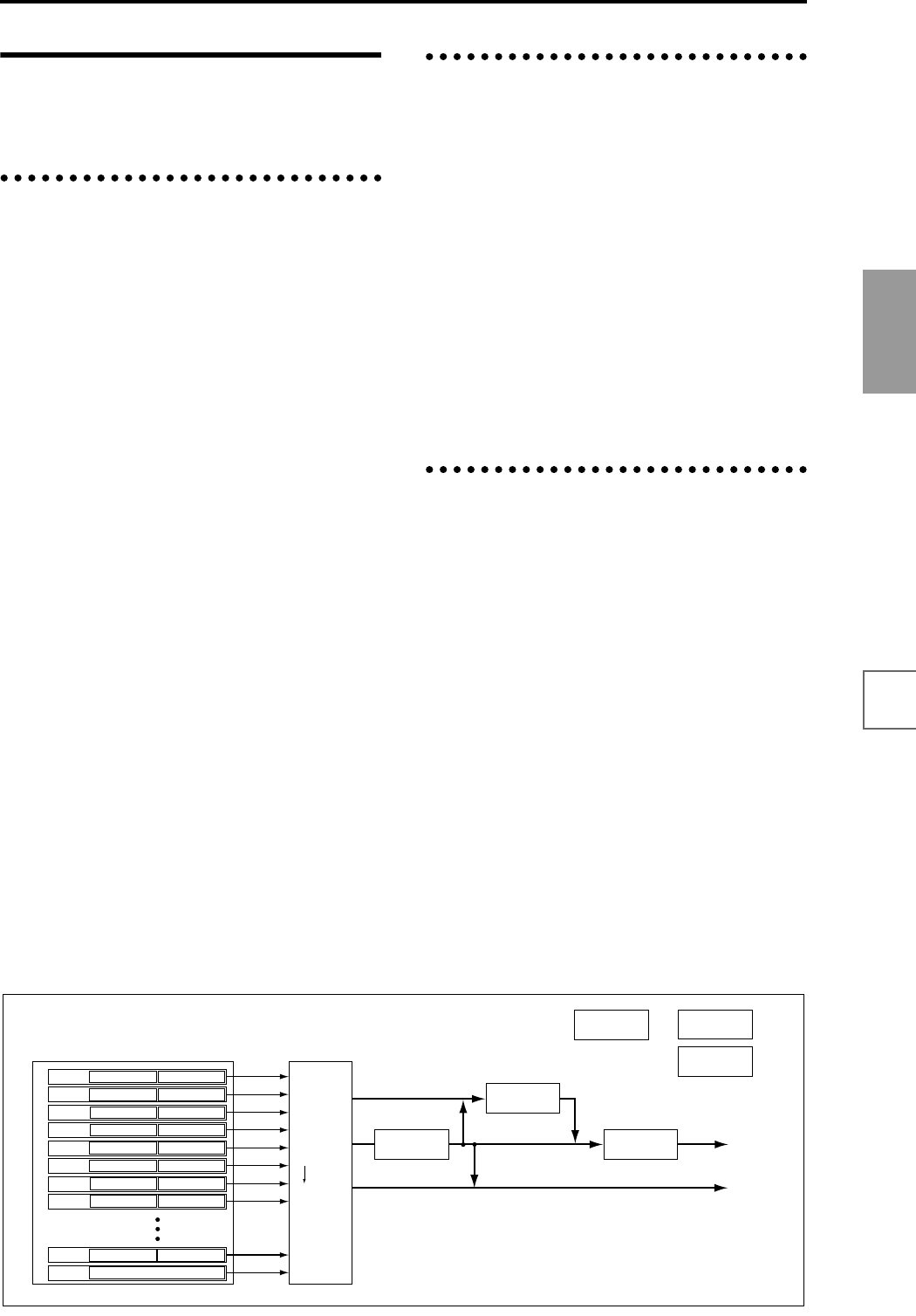
81
Basic functions
Saving dataLoading dataProgram
settings
Combination
settings
Producing
songs
Sampling
settings
Creating a
CD
SMF
playback
System
settings
Drum kit
settings
Arpeggiator
settings
Effects
settings
Other
functions
The structure of Sequencer mode
The following describes the structure of Sequencer mode.
(☞diagram below)
Songs
A song consists of tracks 1–16, a master track, song
parameters such as the song name, effect, arpeggiator and
RPPR parameters, and 100 user patterns.
A maximum of 200 such songs can be created on TRITON
STUDIO.
Tracks 1–16 and the master track each consist of setup
parameters located at the start location, and musical data
within the track.
Setup parameters
Tracks 1–16
Bank/Program No.*, PLAY/MUTE/REC, Pan*, Vol-
ume*, Track Play Loop, Loop Start Measure, Loop End
Measure, Play Intro, Status, MIDI Channel, Bank Select
(When Status=EX2), Force OSC Mode, OSC Select, Por-
tamento*, Transpose**, Detune**, Bend Range**, Delay,
Use Program's Scale, MIDI Filter, Key Zone, Velocity
Zone, Track Name, Arpeggiator Assign, IFX/Indiv.Out
BUS Select, Send1(MFX1)*, Send2(MFX2)*
Master track
Time signature*, Tempo*
Musical data
Tracks 1–16
Note On/Off, Program Change (including Bank
Select), Pitch Bend, After Touch (Poly After), Control
Change, Pattern No.
* When you change the setting during realtime-
recording, this will be recorded as musical data.
This allows the starting settings to be modified dur-
ing the playback.
** Musical data (MIDI RPN data) can be used to
change the starting settings during playback.
For details on control changes and RPN, refer to PG
p.260, 263.
Patterns
There are two types of patterns: preset patterns and user
patterns.
• Preset patterns: Patterns suitable for drum tracks are
preset in internal memory, and can be selected for any
song.
• User patterns: Each song can have up to 100 patterns.
When using a pattern in a different song, use the
Utility menu commands “Copy Pattern” or “Copy
From Song” etc. to copy the pattern. The pattern
length can be specified in units of a measure.
Each pattern consists of musical data for one track. It is
not possible to create patterns that contain multiple tracks.
These patterns can be used as track musical data by being
placed in a track (page menu command “Put to Track”) or
copied to a track (page menu command “Copy to Track”).
Alternatively, you can use a pattern with the RPPR func-
tion of a song.
Cue List
A cue list allows you to playback multiple songs in suc-
cession. The TRITON STUDIO allows you to create 20 cue
lists. Each cue list allows you to connect a maximum of 99
songs in any order, and to specify the number of times
that each song will repeat.
The page menu command “Convert to Song” lets you
convert the two or more songs in a cue list into a single
song. This allows you to use a cue list to create the back-
ing, then convert the cue list into a song and add solo
phrases on unused tracks.
Insert Effect 1 ... 5 : P8
AUDIO OUTPUT
L/MONO, R
Master Effect 1, 2 : P9
AUDIO OUTPUT
INDIVIDUAL 1,2,3,4
MasterEQ : P9
Controller Setup : P4- 4
Arpeggiator : P7
Routing : P8-1
Track
Insert Effect
Master Effect
Individual Outputs
Track 1
Parameter settings Musical data
Track 2
Parameter settings Musical data
Track 3
Parameter settings Musical data
Track 4
Parameter settings Musical data
Track 5
Parameter settings Musical data
Track 6
Parameter settings Musical data
Track 7
Parameter settings Musical data
Track 8
Parameter settings Musical data
Track 16
Parameter settings Musical data
Master Track
Tempo, Time signature data
Pattern U00 ... U99
RPPR Setup
: P6


















